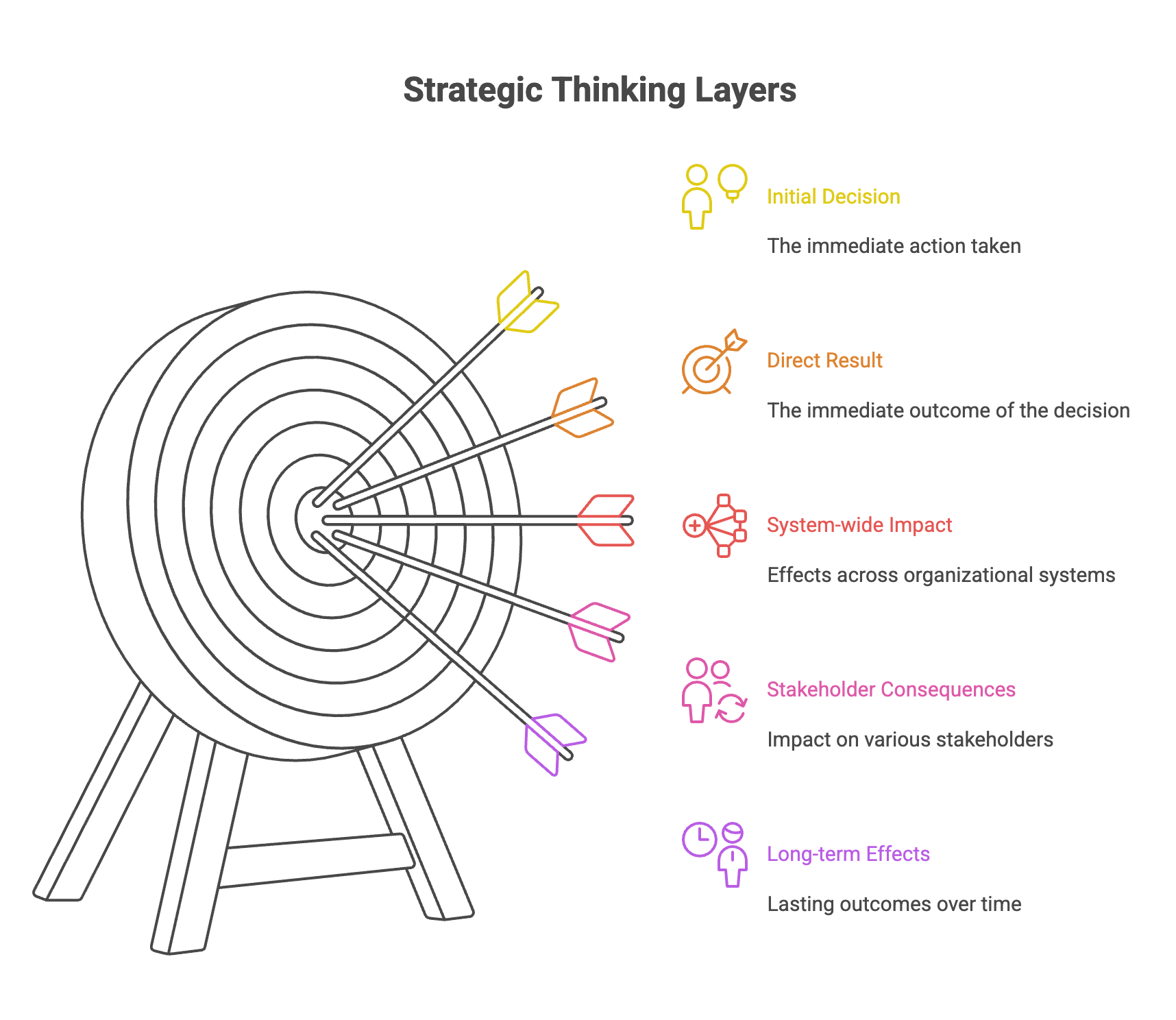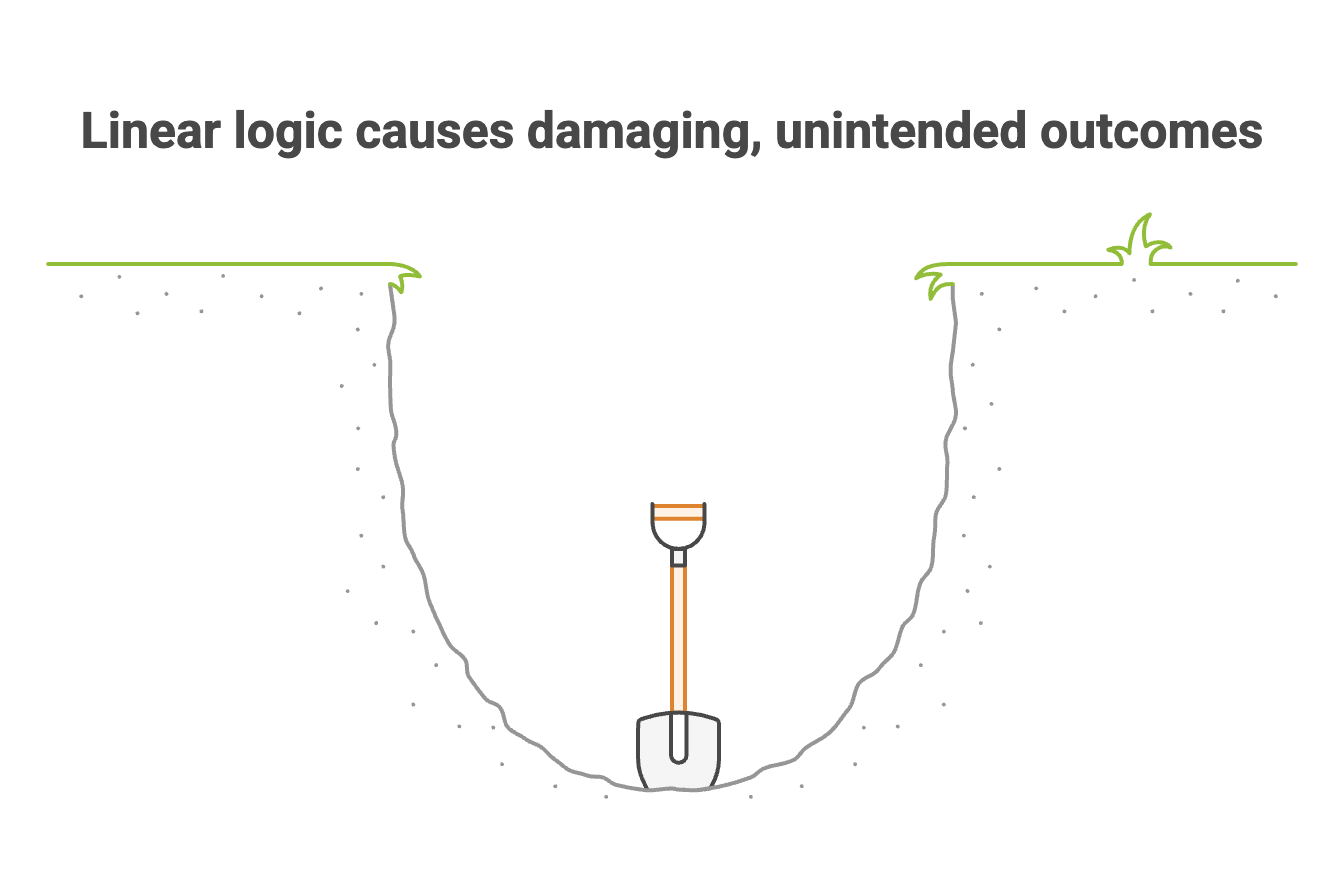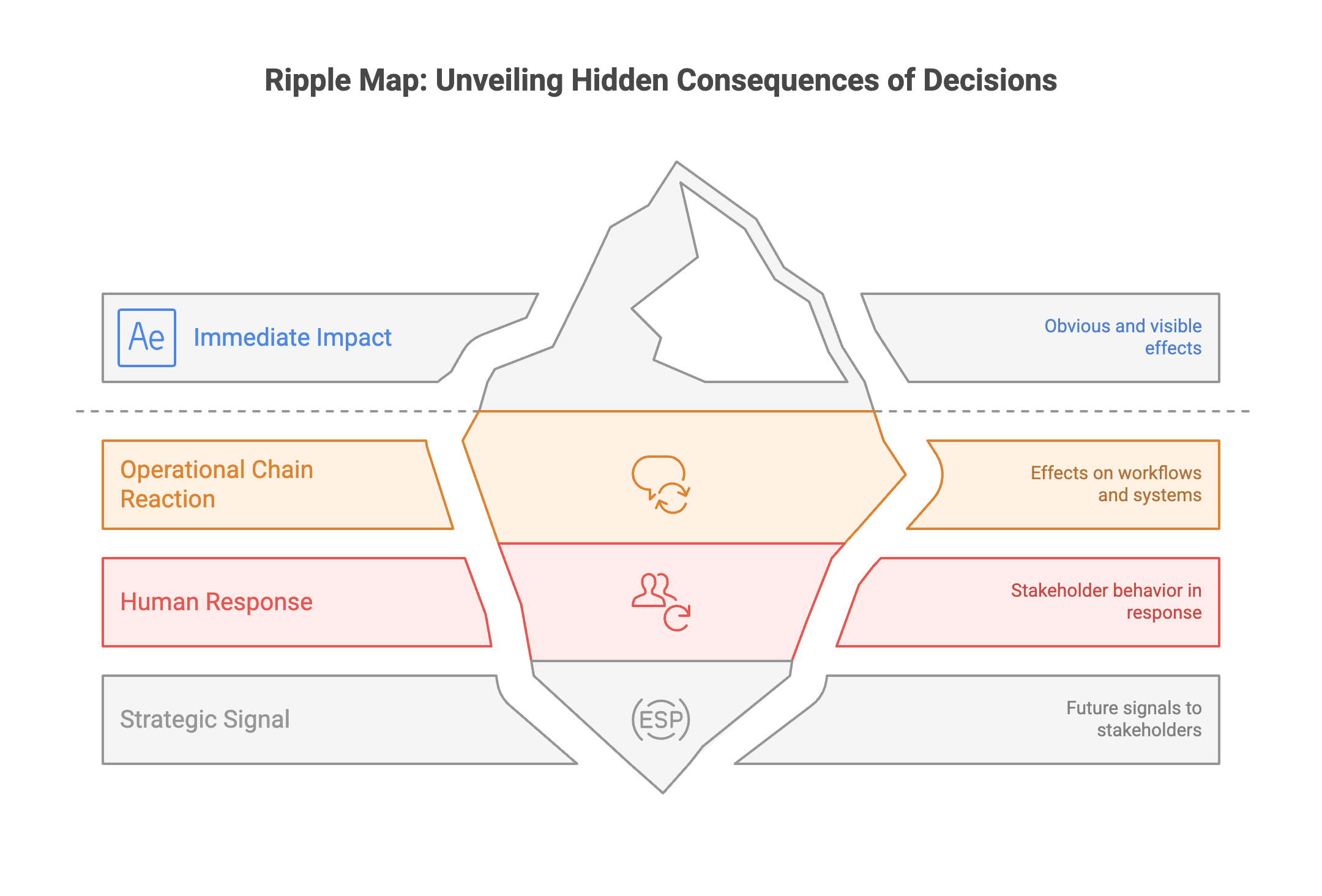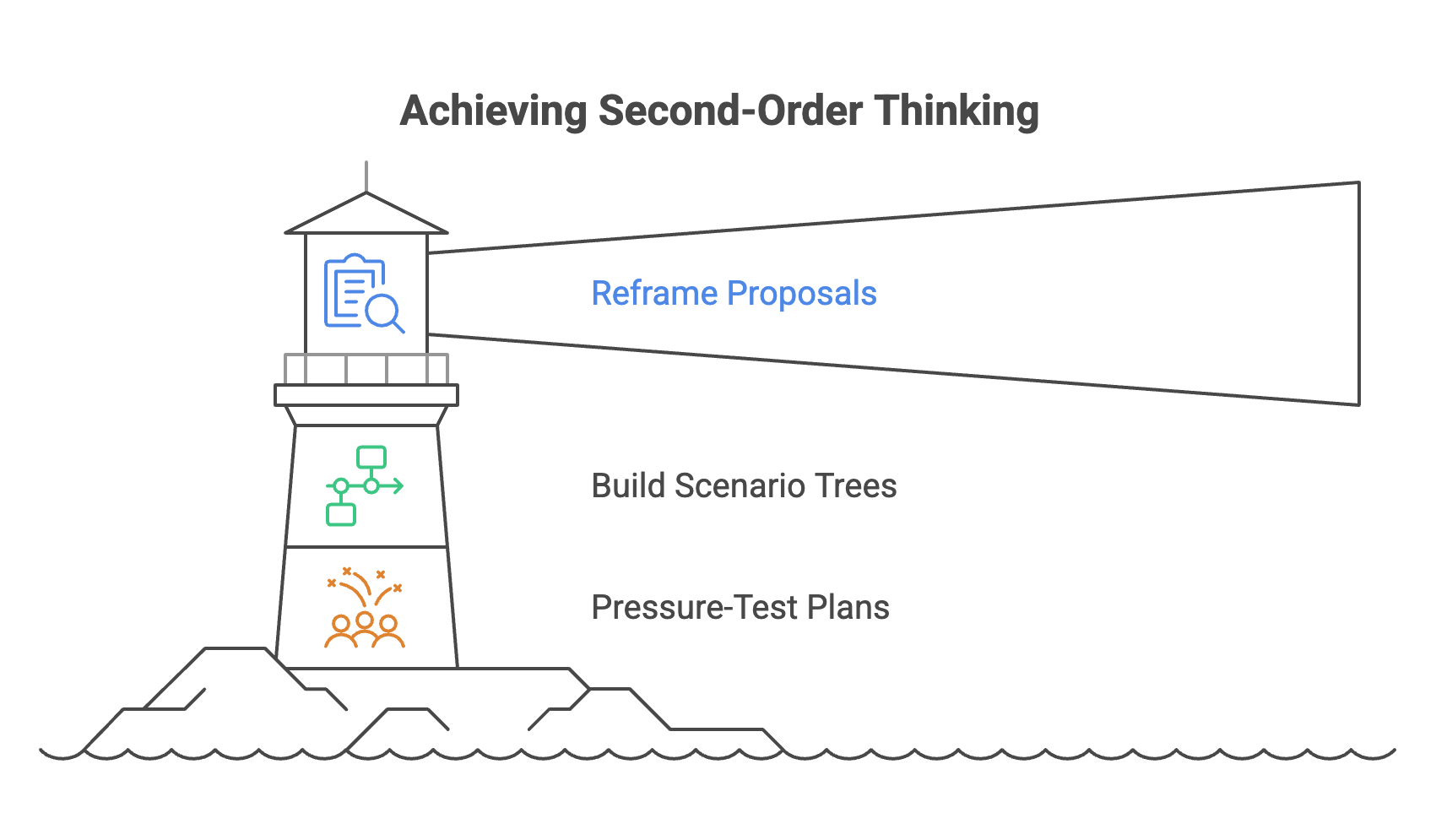Mental Model
July 15, 2025
5
Min
Second-Order Thinking: How to Predict Consequences Like a Strategist
Critical Thinking
|
It’s a question we’ve posed in boardrooms and strategy offsites for over a decade. Not in response to a plan’s ambition - but its simplicity. Bold ideas often come neatly packaged: launch the AI pilot, restructure the BU, roll out the new pricing model. Everyone nods. It feels decisive.
Then we ask again, slower this time: Do you know what happens next… after that?
The silence is usually telling.
The best strategists think in layers. They anticipate not just the direct result of a decision, but the cascade it sets off - across systems, stakeholders, timeframes. This is second-order thinking. And in our experience, it’s the difference between reactive firefighting and durable strategic advantage.

In a 2023 McKinsey survey, 58% of senior leaders admitted they’ve made “high-confidence decisions” that produced unintended, and often damaging, outcomes. The culprit? Overreliance on linear logic.
First-order thinking focuses on immediate, visible effects:
But organisations don’t operate in a vacuum. Every decision sends ripples through people, culture, customers, compliance, and capacity. And those second- and third-order ripples are where the real consequences live.
This matters because complexity is no longer the exception - it’s the backdrop. Strategy in 2025 demands more than directional thinking. It demands dimensional thinking.

We use a tool we call the Ripple Map - a four-layer method that helps leadership teams slow down, zoom out, and make decisions with consequence-awareness.
This is what everyone sees. It’s the headline effect.
Example: We switch suppliers to cut costs by 15%.
🌀 Reflection prompt: Are we mistaking the immediate benefit for the full picture?
Here we examine how the decision affects workflows, incentives, and systems.
Same example: Switching suppliers disrupts procurement protocols, requires retraining warehouse staff, and delays inventory due to unfamiliar lead times.
Action Step: Schedule a 30-minute impact mapping session with frontline managers.
How will stakeholders behave in response? Not how should they behave, but how will they behave?
Example: Procurement teams feel blindsided. Supplier loyalty erodes. Customer service deals with stockouts. Trust takes a hit.
Micro-action: Run a reverse-brief with your middle managers. Ask what they think others will do next.
Finally, what future signals are we sending - to the market, to talent, to regulators?
Example: Cutting supplier ties may lower ESG ratings, raise compliance flags, and suggest short-termism to investors.
🌀 Reflection prompt: What story are we unintentionally telling?

It’s not enough to have the mindset - we need to institutionalise it. Here’s how we help leadership teams build second-order rigour into decision-making:
Reframe Every Proposal with a “Then What?” Layer
Require every initiative brief to include second- and third-order consequences - positive and negative.
Pro Tip: Make “Best Case / Worst Ripple” a recurring slide in all decision decks.
Build Scenario Trees, Not Lists
Use branching diagrams to map “if this, then that” paths over time. Let leaders see how today’s decisions might evolve six, twelve, or twenty-four months out.
Pressure-Test Plans with Role-Play
Assign leaders to argue from the view of investors, frontline staff, regulators, or customers. This forces lateral anticipation.
Pro Tip: Invite a wildcard participant - not from the decision's core team - to spot blind spots.

Prompt 1: What’s a recent decision where the second-order consequences surprised you? What assumptions did you make at the time?
Prompt 2: Before greenlighting your next major initiative, ask: Who benefits? Who absorbs the ripple? What future might we be setting in motion?
When leaders embed second-order thinking:
And perhaps most importantly, leaders start to develop that rarest of strategic muscles - discernment. The ability to not just do what’s right, but to time it well, communicate it clearly, and anticipate its evolution.
This isn’t about risk-aversion. It’s about consequence fluency.
Pull up your most recent big decision - whether it’s a reorg, investment, or policy shift.
Now ask your team:
Map it out. Better yet, make it visible. We’ve seen post-it walls, digital whiteboards, even mural diagrams catalyse richer strategy conversations.
If you’d like a Ripple Map template or want to test-drive this in your next leadership offsite, drop us a note.
Team SHIFT
“Do you know what happens next?”
It’s a question we’ve posed in boardrooms and strategy offsites for over a decade. Not in response to a plan’s ambition - but its simplicity. Bold ideas often come neatly packaged: launch the AI pilot, restructure the BU, roll out the new pricing model. Everyone nods. It feels decisive.
Then we ask again, slower this time: Do you know what happens next… after that?
The silence is usually telling.
The best strategists think in layers. They anticipate not just the direct result of a decision, but the cascade it sets off - across systems, stakeholders, timeframes. This is second-order thinking. And in our experience, it’s the difference between reactive firefighting and durable strategic advantage.

In a 2023 McKinsey survey, 58% of senior leaders admitted they’ve made “high-confidence decisions” that produced unintended, and often damaging, outcomes. The culprit? Overreliance on linear logic.
First-order thinking focuses on immediate, visible effects:
But organisations don’t operate in a vacuum. Every decision sends ripples through people, culture, customers, compliance, and capacity. And those second- and third-order ripples are where the real consequences live.
This matters because complexity is no longer the exception - it’s the backdrop. Strategy in 2025 demands more than directional thinking. It demands dimensional thinking.

We use a tool we call the Ripple Map - a four-layer method that helps leadership teams slow down, zoom out, and make decisions with consequence-awareness.
This is what everyone sees. It’s the headline effect.
Example: We switch suppliers to cut costs by 15%.
🌀 Reflection prompt: Are we mistaking the immediate benefit for the full picture?
Here we examine how the decision affects workflows, incentives, and systems.
Same example: Switching suppliers disrupts procurement protocols, requires retraining warehouse staff, and delays inventory due to unfamiliar lead times.
Action Step: Schedule a 30-minute impact mapping session with frontline managers.
How will stakeholders behave in response? Not how should they behave, but how will they behave?
Example: Procurement teams feel blindsided. Supplier loyalty erodes. Customer service deals with stockouts. Trust takes a hit.
Micro-action: Run a reverse-brief with your middle managers. Ask what they think others will do next.
Finally, what future signals are we sending - to the market, to talent, to regulators?
Example: Cutting supplier ties may lower ESG ratings, raise compliance flags, and suggest short-termism to investors.
🌀 Reflection prompt: What story are we unintentionally telling?

It’s not enough to have the mindset - we need to institutionalise it. Here’s how we help leadership teams build second-order rigour into decision-making:
Reframe Every Proposal with a “Then What?” Layer
Require every initiative brief to include second- and third-order consequences - positive and negative.
Pro Tip: Make “Best Case / Worst Ripple” a recurring slide in all decision decks.
Build Scenario Trees, Not Lists
Use branching diagrams to map “if this, then that” paths over time. Let leaders see how today’s decisions might evolve six, twelve, or twenty-four months out.
Pressure-Test Plans with Role-Play
Assign leaders to argue from the view of investors, frontline staff, regulators, or customers. This forces lateral anticipation.
Pro Tip: Invite a wildcard participant - not from the decision's core team - to spot blind spots.

Prompt 1: What’s a recent decision where the second-order consequences surprised you? What assumptions did you make at the time?
Prompt 2: Before greenlighting your next major initiative, ask: Who benefits? Who absorbs the ripple? What future might we be setting in motion?
When leaders embed second-order thinking:
And perhaps most importantly, leaders start to develop that rarest of strategic muscles - discernment. The ability to not just do what’s right, but to time it well, communicate it clearly, and anticipate its evolution.
This isn’t about risk-aversion. It’s about consequence fluency.
Pull up your most recent big decision - whether it’s a reorg, investment, or policy shift.
Now ask your team:
Map it out. Better yet, make it visible. We’ve seen post-it walls, digital whiteboards, even mural diagrams catalyse richer strategy conversations.
If you’d like a Ripple Map template or want to test-drive this in your next leadership offsite, drop us a note.
Team SHIFT
“Do you know what happens next?”
It’s a question we’ve posed in boardrooms and strategy offsites for over a decade. Not in response to a plan’s ambition - but its simplicity. Bold ideas often come neatly packaged: launch the AI pilot, restructure the BU, roll out the new pricing model. Everyone nods. It feels decisive.
Then we ask again, slower this time: Do you know what happens next… after that?
The silence is usually telling.
The best strategists think in layers. They anticipate not just the direct result of a decision, but the cascade it sets off - across systems, stakeholders, timeframes. This is second-order thinking. And in our experience, it’s the difference between reactive firefighting and durable strategic advantage.

In a 2023 McKinsey survey, 58% of senior leaders admitted they’ve made “high-confidence decisions” that produced unintended, and often damaging, outcomes. The culprit? Overreliance on linear logic.
First-order thinking focuses on immediate, visible effects:
But organisations don’t operate in a vacuum. Every decision sends ripples through people, culture, customers, compliance, and capacity. And those second- and third-order ripples are where the real consequences live.
This matters because complexity is no longer the exception - it’s the backdrop. Strategy in 2025 demands more than directional thinking. It demands dimensional thinking.

We use a tool we call the Ripple Map - a four-layer method that helps leadership teams slow down, zoom out, and make decisions with consequence-awareness.
This is what everyone sees. It’s the headline effect.
Example: We switch suppliers to cut costs by 15%.
🌀 Reflection prompt: Are we mistaking the immediate benefit for the full picture?
Here we examine how the decision affects workflows, incentives, and systems.
Same example: Switching suppliers disrupts procurement protocols, requires retraining warehouse staff, and delays inventory due to unfamiliar lead times.
Action Step: Schedule a 30-minute impact mapping session with frontline managers.
How will stakeholders behave in response? Not how should they behave, but how will they behave?
Example: Procurement teams feel blindsided. Supplier loyalty erodes. Customer service deals with stockouts. Trust takes a hit.
Micro-action: Run a reverse-brief with your middle managers. Ask what they think others will do next.
Finally, what future signals are we sending - to the market, to talent, to regulators?
Example: Cutting supplier ties may lower ESG ratings, raise compliance flags, and suggest short-termism to investors.
🌀 Reflection prompt: What story are we unintentionally telling?

It’s not enough to have the mindset - we need to institutionalise it. Here’s how we help leadership teams build second-order rigour into decision-making:
Reframe Every Proposal with a “Then What?” Layer
Require every initiative brief to include second- and third-order consequences - positive and negative.
Pro Tip: Make “Best Case / Worst Ripple” a recurring slide in all decision decks.
Build Scenario Trees, Not Lists
Use branching diagrams to map “if this, then that” paths over time. Let leaders see how today’s decisions might evolve six, twelve, or twenty-four months out.
Pressure-Test Plans with Role-Play
Assign leaders to argue from the view of investors, frontline staff, regulators, or customers. This forces lateral anticipation.
Pro Tip: Invite a wildcard participant - not from the decision's core team - to spot blind spots.

Prompt 1: What’s a recent decision where the second-order consequences surprised you? What assumptions did you make at the time?
Prompt 2: Before greenlighting your next major initiative, ask: Who benefits? Who absorbs the ripple? What future might we be setting in motion?
When leaders embed second-order thinking:
And perhaps most importantly, leaders start to develop that rarest of strategic muscles - discernment. The ability to not just do what’s right, but to time it well, communicate it clearly, and anticipate its evolution.
This isn’t about risk-aversion. It’s about consequence fluency.
Pull up your most recent big decision - whether it’s a reorg, investment, or policy shift.
Now ask your team:
Map it out. Better yet, make it visible. We’ve seen post-it walls, digital whiteboards, even mural diagrams catalyse richer strategy conversations.
If you’d like a Ripple Map template or want to test-drive this in your next leadership offsite, drop us a note.
Team SHIFT
